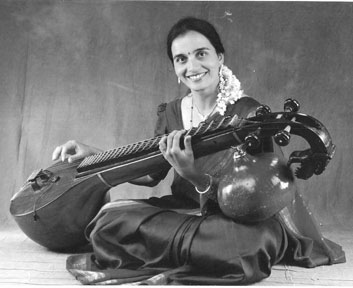The development of Carnatic Classical Music and dance in different
periods
By Subashini PATHMANATHAN
Normally in all of dance forms, whether it is ritual or religious, or
classical, or folk, or any sort of dance forms, the music is the soul,
strength, to any dance forms. Music which inspires the human mind,
influences any dance of worldwide music and dance are inter-woven. At
the same time the music not only means the vocal music alone but also,
it means the instrumental music. In earlier days the instruments used
for dance were called 'Geethangam', and the instruments used for nirtha
(steps) were called 'Nirthangam'.
In India the classical music is often referred as Sangeetham, or
sangeeth. It includes only vocal, instrumental, and or a combination of
vocal and instrumental. Natya Sastra of Bharatha muni provides a wealth
of information about the nuances of dance, drama, music and related
fields. According to Natya Sastra, music without dance is like a
painting without colours.The ancient Tamil classic Sillapathykaram, and
the oldest Tamil grammar Tholkapiyam provides a wealth of information
about the musical traditions of those days and various nuances of dance
and music of earlier days.
 Besides these Tamil Nadu was under various rulers and cultural
concepts which faced various stances in different eras. During the
period of Pallavars art, culture, religious values, and traditions were
well protected and preserved to some extent. Besides these Tamil Nadu was under various rulers and cultural
concepts which faced various stances in different eras. During the
period of Pallavars art, culture, religious values, and traditions were
well protected and preserved to some extent.
After the period of Pallavars the Chola period came into existence,
during this period royal patronage was given to the fine arts and
religion. Specially to dance, music, drama, painting, sculpture and
architecture, special attention was paid by different rulers. This era
was considered a golden era in the history of Tamil land. After the
Chola period the Nayaka period came into existence. Generally Nayaka
period in Tamil literature was considered as a dark period. But in the
development of history of dance and music, there was a considerable
progress which took place.
During the period of Nayaka, beautiful and numerous compositions
suitable for dance were enacted. Some of the beautiful Telugu padams
were enacted, and some of the Padams were enacted by the rulers
themselves. It was believed that the earlier temple dance Sathir, got a
rational format only during this period. A famous Telugu epic named, 'Valmiki
Charithram', was written by one Nayaka ruler called Ragunatha Nayak, who
created and introduced two imaginative dance characters.
And he created a dance competition between these two imaginative
dance characters Rampa, and Urvasi. In the epic numerous dance and
musical nuances are mentioned. According to Ragunatha, Urvasi danced
twenty three dances, and Rampa danced four different varieties of dance
forms. This showed the numerous dance forms, and different variety of
dance forms which, existed during that time. He further mentioned about
some number of Asamutha hastas (single hand muthras), Samutha hastas,
(double hand muthras), nirtha muthras (step hand muthras', body
positions, neck movements, side body positions, and leg positions etc.
This reveals that how the dance tradition of those days were
preserved, with certain high norms. Further in his epic he mentioned
numerous musical instruments used during those time for dance, including
string instruments, leather instruments and other variety, of various
instruments.
A greatest Telugu poet Kashetrajna who visited Thanchai during the
period of Nayak King Vijeyaragava Nayak, and the King Thirumalai,
enacted beautiful Telugu padams. More or less the terms Sangeetha Mela,
Chinna Mela, and Periya Mela came into existence during this period in
the music and dance world.
Hence during the of Nayaka period as far as dance and music are
concerned, both these fields faced tremendous changes and development.
During the rule of King Serfogi, of Thanchai (1798-1832), he mentioned
numerous dance items during his time, in his work"sangeetha saramirtham'.
These items were curtailed and a repertoire was formulated by the
four brothers who were collectively called Thanjavaur Quartette.
|

